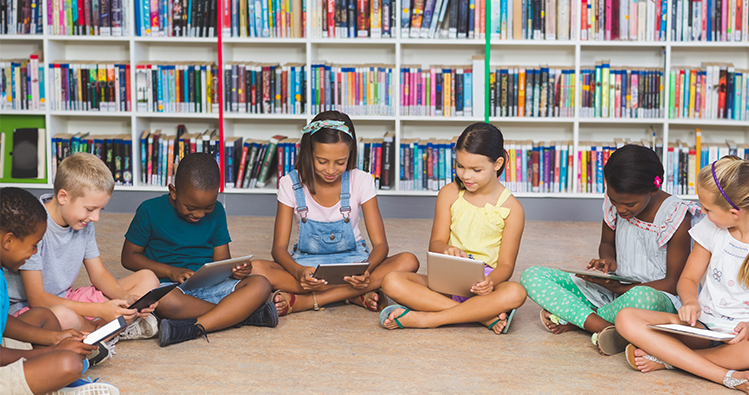Is Personalized Learning the Future of Education?
Written by:
Kajeet

More than likely, when you went to school — whether it was 10 years ago or 50—the educational model was probably the same (and one we took for granted). Everyone sat in ordered rows. Lesson plans were the same. Homework assignments were the same. Tests and quizzes were the same.
It was democratic. It was equal. It was the one-size-fits-all model of education.
But that model is beginning to change. More and more, 21st-century students are learning the same subjects — but in ways that are highly tailored to their specific skills, needs, and interests.
Learning, it appears, has gotten personal.
Education Made Personal
It goes by many names. Personalized learning. Personalization. Student-centered learning.
However you choose to define it, this new educational model is on the rise. Schools and districts across the country are experimenting with diverse ways to tailor and target curriculum and lesson plans to address the commonly accepted idea that students are unique, and each student learns best in his or her own way.
The goal of personalized learning is “to make individual learning needs the primary consideration in important educational and instructional decisions, rather than what might be preferred, more convenient, or logistically easier for teachers and schools.”
In other words, the needs of the student always come first. Regardless of their individual aspirations, cultural background, or learning style.
Technology Matters
So what’s made personalized learning so popular?
One of the key drivers behind its proliferation across the country, undoubtedly, is the increasing access to and incorporation of technology in classrooms where it wasn’t there before.
In fact, there’s a powerful link between personalized learning and technology such as 1:1 programs, filtered Education Broadband™, and social media tools. Technology makes it easier for teachers to adapt and alter classroom lessons in ways that couldn’t be dreamed of back in the days of dusty green chalkboards and rattling transparent projectors.
The adoption of personalized learning approaches “has increased significantly in recent years due in part to rapid advances in technology platforms and digital content,” according to a 2015 study funded by the Bill and Melinda Gates Foundation which studied 62 public charter and district schools over two years.
What the study found shows strong positive results in classrooms that adopted more personalized learning strategies for their students.
- Students made significant gains in mathematics and reading.
- The longer students experience personalized learning, the greater their achievement growth.
- Student achievement on math and reading assessments jumped above the national median.
- Most students exceeded their comparison group peers in mathematics and reading growth.
While it’s important to recognize the relatively small size of this sample, the report is nevertheless a positive indicator that personalized learning isn’t just a fad, but a real methodology that has the potential to produce real, lasting results in tomorrow’s students.
Personal Tech Tools
So what are some of the ways educators are using technology to make their classrooms more personalized than ever before?
- Multi-purpose multimedia. Tech tools have made learning more hands on. Video clips, animations, games, and interactive whiteboards are just some of the many multimedia tools that can be used to develop unique learning experiences and multiple avenues of instruction.
- Apps galore. It seems like more and more educational apps hit the market every day, each of which can be used to add unique, personalized spins to classroom lessons. Among these apps are Educreations (which are short, teacher-created lessons that can be paused and rewound) and Classkick (which allows for private teacher feedback — including virtually raised hands).
- Software Skills. One strategy for effective personalized learning is using existing skills-based software (including EducationCity and Study Island) to assess and hone a student’s math and reading skills. What this does is pave the way (and create the time) for more creative, outside-the-box lessons in the classroom.
The Human Elements
Technology is only a part of what makes personalized learning so promising, according to the RAND Corporation. The future won’t just be students staring at screens, oblivious to the people (and world) around them.
As much emphasis as we put on the relationship between technology and personalized learning, it doesn’t mean that teachers still don’t play a powerful, all-important role in cultivating their charges.
“[I]n researching personalized learning we have found that teachers play an integral role in designing and managing the learning environment, leading instruction, and providing expert guidance and support while encouraging students to take increasing ownership of their learning,” write RAND Senior Scientist John F. Pane and RAND Education Associate Director Laura S. Hamilton.
And there are a host of challenges school districts will need to consider as personalized learning becomes more and more prevalent (and popular). Some of the barriers to change listed in an illuminating study stemming from a 2015 Technology-Enabled Personalized Learning Summit include:
- the significant cost of adapting existing data collection systems (or creating new ones) to districts;
- redefining educational roles to compensate for technology-enabled skills and requirements; and
- vetting and curating learning resources used in digital personalized learning.
Technology, however fascinating and instrumental in personalized learning, isn’t a cure-all. But it is a powerful tool that, when used responsibly and in conjunction with more human elements of education, has the potential to help make a student’s education more personal, more effective — and more unforgettable.

